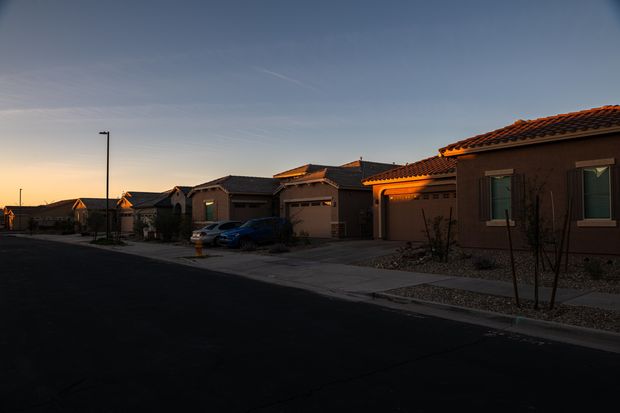Shawn Zangler had often thought about buying a home with her mother. When the pandemic hit, she finally did it.
Ms. Zangler, 57, and her mother, Joy Lewis, 76, bought a house together in Surprise, Ariz., last August. Ms. Zangler is paying the mortgage, but Ms. Lewis paid more than half the down payment.
“It’s a win-win for me and my family,” said Ms. Zangler, who had fretted about her mother living alone in the Covid-19 pandemic. “This way we don’t have to worry.” Ms. Zangler’s 18-year-old son lives with them too, and she expects her daughter will move in temporarily after finishing college.
Parents and children, siblings and grandparents are shacking up during the pandemic, opting for living in close quarters over quarantining from each other. Some 15% of people who bought homes between April and June of last year planned to have multiple generations living there, according to a survey by the National Association of Realtors. That is up from 11% of those who bought between July 2019 and March 2020, and the highest level in survey data going back to mid-2012.
The joint-venture home purchase represents just one way Covid-19 has upended Americans’ living situations. Many millennials are moving back to their childhood homes, and Gen X-ers are putting in garage apartments or backyard houses for elderly parents.
Jessica Lautz, vice president of demographics and behavioral insights at the Realtors association, expects the share of adult children and parents buying homes together to continue to increase.
The recent jump was primarily attributable to people who wanted to take care of their aging parents, she said.
Saving money is an important consideration too: Tight housing supply drove the median existing-home price to $303,900 in January, up 14% from a year earlier, according to the NAR.
Ms. Zangler had hesitated to buy with her mother in the past because Ms. Lewis is a smoker. But the
Lennar Corp.
-designed home they bought was made for multigenerational living. The living space for Ms. Lewis includes a separate entrance, kitchen and air-conditioning unit. Ms. Zangler and her son contracted Covid-19 last year, but her mother stayed in her part of the house and didn’t get sick, she said.
Ms. Zangler looks into her new backyard with her mother, Ms. Lewis, and son, Ryan Zangler.
Roughly 3% of
Zillow Group Inc.
listings in February included terms that signal multiple generations could live in them, like “granny suite” or “in-law cottage,” according to analysis by the online real-estate company.
House listings with these kinds of descriptive words had a median listing price of $598,000 and sold 23% faster in February compared with a year earlier, according to Realtor.com. For all home listings in February, the median listing price was $353,000 and the homes sold 14% faster. (
parent of The Wall Street Journal, operates Realtor.com.)
SHARE YOUR THOUGHTS
How has the pandemic changed your living arrangements? Are you planning to make those changes permanent? Join the conversation below.
Sisters Annie and Katie Kirking of Seattle moved their parents out of an assisted living facility in August into Katie’s 900-square-foot, two-bedroom apartment. Before the pandemic, they had visited their parents daily, and they thought their parents’ health deteriorated when the daughters were unable to visit because of the pandemic.
The family had long talked about moving to Spokane, Wash., where they grew up. The Kirking sisters are in the process of buying a four-bedroom house there and plan to live with their parents, Annie’s partner and their 2-year-old daughter, Evie.
Annie and Katie have pooled their savings and are selling some belongings to cover the down payment, moving expenses and upfront home repairs, they said. After they move, their monthly mortgage payment will cost less than what they pay to rent in Seattle.
“We’re very grateful that we can do this together,” Annie Kirking said. “I can feel pulled between making decisions that are best for Evie and decisions that are best for my parents.…Being under one roof, I think that push and pull will be much less.”
Melissa Cohn, a mortgage banker in New York and Florida, recently worked with a family where the parents and daughter went in on a three-bedroom apartment in Brooklyn as a pied-à-terre for the parents and a primary residence for the daughter. Andrea Pettitt, a real-estate agent in Boise, Idaho, had clients that sold a house last year to buy one that could fit an elderly father.
Home builder Lennar launched its Next Gen homes designed for multigenerational households in 2011, in response to the growing need for elder care, said Lennar co-chief executive and co-president
Jon Jaffe.
Next Gen homes cost about $10,000 more than typical Lennar homes without the additional suite, he said.
Next Gen home sales rose faster than overall Lennar sales during the pandemic, Mr. Jaffe said, and the company plans to build a larger share of Next Gen homes going forward. He attributed some of the current demand to multigenerational households and some to home buyers wanting the additional suites for home offices or recreational use.
Raquel Lavender, a real-estate agent in the Atlanta area, recently sold a home to a family where the mother and children lived on the main floor and the grandmother lived in the basement. A decade ago, she said, she would have called the basement a “recreation room” on the listing, but now she calls it an “in-law suite.”
Ms. Lavender said she believes that economic uncertainty has prompted some families to pool their money. “There is a fear,” she said, “that maybe the economy is not going to bounce back as expected.”

Cars parked at Shawn Zangler’s new home in Surprise, Ariz. She chose it in part because her mother needs her own space and air-conditioning system.
Write to Nicole Friedman at nicole.friedman@wsj.com and Ben Eisen at ben.eisen@wsj.com
Copyright ©2020 Dow Jones & Company, Inc. All Rights Reserved. 87990cbe856818d5eddac44c7b1cdeb8






